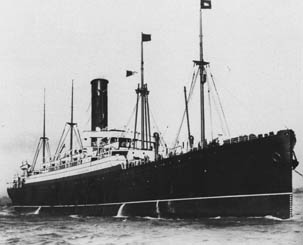 I found on www.ancestry.com the immigration record of Albert Edward Hanson. He arrived in Boston Harbor 21 Apr 1904, from Birmingham England. They sailed out of Liverpool England. Upon his arrival he was to travel to the address of 61 South Elm St, Manchester, NH. This immigrator was probably my grandfather Hanson.
I found on www.ancestry.com the immigration record of Albert Edward Hanson. He arrived in Boston Harbor 21 Apr 1904, from Birmingham England. They sailed out of Liverpool England. Upon his arrival he was to travel to the address of 61 South Elm St, Manchester, NH. This immigrator was probably my grandfather Hanson.Here is an article about the ship he sailed on:

Saxonia (I)
1900 - 1925
owards the very end of the 19th century, the largest Cunard liners were the Campania and Lucania. Both well over 10,000 gross tons, they had ensured Britain’s maritime might by winning the prestigious Blue Riband. However, in 1897, the German shipping company Norddeutscher Lloyd introduced the stunning Kaiser Wilhelm der Grosse who bettered the Atlantic crossing-time speed with approximately half a knot. This was more than the Campania and Lucania could ever manage, and as the British rival White Star were planning the 17,000 gross ton Oceanic, Cunard had to invest in new liners.
The ultimate beat back for Cunard was not to come at once, though. Before aiming for
| The Saxonia, in this picture riding high in the water. |
The Ivernia was launched by C. S. Swan & Hunter in late 1899, and entered service in April 1900. At close to 14,000 gross tons, she was the largest Cunarder ever built. However, her honour would not be for long as the second vessel – the Saxonia – was to enter service in another month, and she was to be even larger.
The Saxonia had been launched at the John Brown shipyard on December 16, 1899. The fitting out continued until mid-May 1900, and she set out on her maiden voyage from Liverpool to Boston on the 22nd. She was equipped with steam quadruple expansion engines, which were geared to the two propellers. This machinery gave the Saxonia a service speed of 15 knots. Cunard had aimed for size this time, and not speed. The Saxonia’s gross tonnage was 14,281, which made her the largest Cunarder to date.
The outward appearance of the Ivernia and Saxonia was special. The long, black hull sported a low, well-balanced superstructure and four masts. On the superstructure stood a single funnel with the extraordinary height of 106 feet. Until this day, it is believed that this funnel (along with the Ivernia’s) is the tallest ever put on a liner.
The Saxonia had been constructed with both passengers and cargo in mind. Her four masts had a good reason – the booms on them were much needed when loading. The cargo space was quite big, and therefore the passenger areas were not as many as expected. In spite the fact that the Saxonia was the largest ship in the entire Cunard fleet, she was not built with prestige in mind – she was merely a money maker. In these hard times, Cunard had to go for every pence they could earn as the ever-expanding American company IMM had their eyes on them, just as on the White Star Line. The Cunard Line had to stand on its own legs. As time would show, Cunard managed to stay out of IMM, but the Americans bought the White Star Line in 1901.
In 1903, the Ivernia and Saxonia were joined by their third ‘sister’ – Carpathia. As she did not exceed the 14,000-ton mark, the Saxonia
| A crowded scene from the Saxonia's upper decks. |
The final strike back for Britain came in 1907, when Cunard introduced the fabulous 30,000-ton Lusitania. She would immediately take back the Blue Riband from the Germans. Only months later, her running mate, the equally large and fast Mauretania entered service. The Lusitania passed over the Blue Riband to her, and she would keep it for an astonishing 22 years.
The Saxonia stayed on the North Atlantic run until 1911 when she was transferred to the Mediterranean service between Trieste and Boston. The following year, her passenger accommodation was altered so that she would only carry second and third class passengers. The Saxonia continued like this until the beginning of World War I.
In August 1914, the liner was used as a troop transport, but only for one voyage. She was then placed on the Thames as an accommodation ship for German prisoners of war. In March 1915, she was taken back as a troop transport. After the war, she was re-installed on the North Atlantic for the route between Liverpool and New York.
The great post-war refit came in 1920, when the Saxonia was thoroughly looked over at Tilbury. The modifications included the shortening of the tall funnel by 16 feet and a transformation of the passenger accommodations. From then on the Saxonia could carry 471 Cabin Class passengers and 978 Third Class passengers. The gross tonnage was after the refit down to 14,197. When she entered service, she was put on the London – New York service. A few years later, an additional stop at Hamburg was introduced.
By 1925, the Saxonia was considered too old and outdated to continue any sort of service. She was sold to the Dutch company Hendrik Ido Ambacht for breaking up before the year had come to an end.




No comments:
Post a Comment